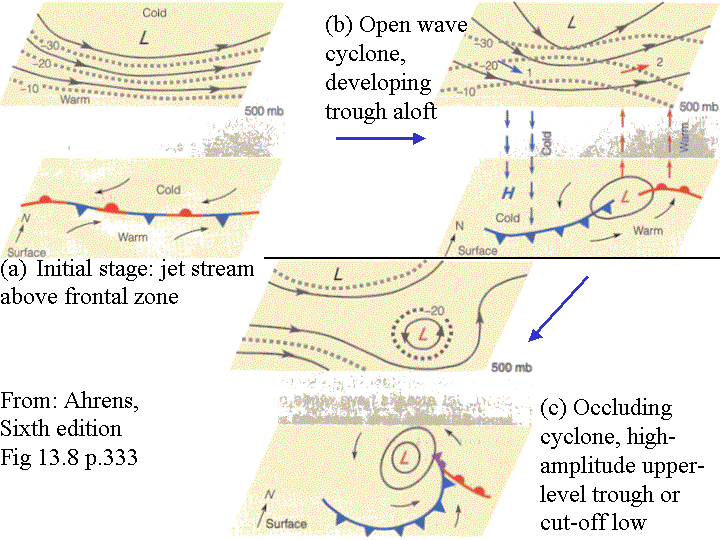Radiation
Differential solar heating of low and high latitudes is what drives the large-scale atmospheric and oceanic circulations of the planet. Most solar energy reaches the Earth as short-wave radiation (insolation) that reaches the surface, although some is reflected back in to space according to the albedo effect; the remained is absorbed and warms the atmosphere above it. The atmosphere and surface radiate thermal (long-wave) radiation back in to space.
This differential solar heating fostered an equator-to-pole gradient in atmospheric and surface ocean temperatures, and Stefan-Boltzmann's law states that every body above absolute 0 (-273C) radiates. Wein's law describes that all bodies at a high temperatures radiates short wavelengths, whilst colder bodies radiate longer wavelengths. The sun behaves virtually as a black body, absorbing all energy received, and radiating energy at the maximum possible rate for a given temperature.
Atmospheric layering is a consequence of the absorption of incoming radiation by water vapour gasses in the atmosphere. The amount of heat absorbed will depend on the specific heat capacity of the surface; land has a lower heat capacity than water, therefore it heats and cools much faster. The oceans are a huge source of stored heat.


Mid-Latitude Disturbances
In the westerly belt there is a complex pattern of moving high and low pressure systems: between 6,000-20,000m there remains a distinct westerly flow. Jinman (1861) held that storms develop where opposing air currents form lines of confluence, which were later called fronts.


The Global Climate System
This is composed of the unstable and rapidly changing atmosphere; the sluggish ocean with a thermal inertia, important for moderating atmospheric variation; the snow and ice cover (a.k.a cryosphere); and land surface - biosphere and lithosphere. The most important interaction is between the dynamic atmosphere and regulating ocean, althought he living matter of the biosphere also plays a key role in the system. The biosphere influences incoming radiation, out-going re-radiation, and the atmospheric composition. Marine biota further play a fundamental role in dissolution and storage of carbon dioxide.
The driving mechanism of global climate is named 'radiative forcing' and anthropogenic forcings has added a new dimension to this. Radiation imbalances have arisen from natural processes and anthropogenic activity. The systems of climate and weather display extreme sensitivity to their initial conditions, and a small change in a weather system may have a disproportionately large impact on the whole. This is known as the Butterfly Effect.
Heat
Heat may be transferred via conduction, and water is far more efficient at this than air - conduction is the means of transfer by molecular agitation.
Free convection is another method, and describes the free rise and movement of air parcels to form cumular-type clouds.
Forced convection describes orogenic displacement, when the air is forced to rise, forming strata-form clouds. This is the movement of heat energy by mass movement.
Advection describes the nearly-horizontal transport of heat by oceans and the atmosphere, such as that found in the Jet Stream.
Sensible heat is that which is exchanged by a body or thermodynamic system that changes the temperature and some macroscopic variables of the body. Volume and pressure will not be affected.
Latent heat is that which is released in a changing material state; in the process of evaporation a vast amount of heat is required to turn water in to vapour, ergo it is stored as the latent heat of vapourisation. This energy is taken from the surface of the oceans. Latent heat transport is responsible for the transfer of large quantities of heat energy in the ocean atmosphere system.
Temperature Variation
Insolation is the absorption of solar radiation by the ground, and the nature of the surface conditions, sucha s moisture content, affects this radiative process. The specific heat capacity for the land is larger than that for the ocean, which warms and cools much more slowly. Cooling the oceans by 0.1C releases enough heat to raise surface air temperature by 10C. Diurnal ranges across the earth are moderated by the oceans. Asia, for instance, warms madly in the summer months, while the converse occurs in the winter, as cold, dense and dry air masses frequently block others, affecting the temperature globally.
No comments:
Post a Comment